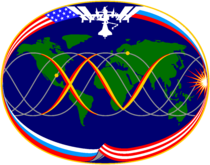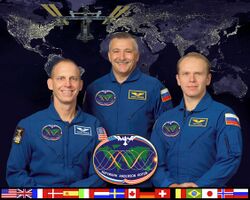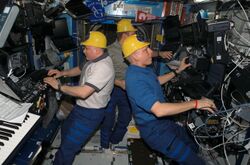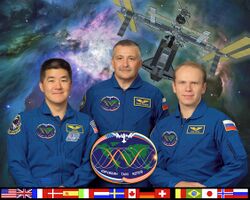Astronomy:Expedition 15
 Promotional Poster | |
| Mission type | ISS Expedition |
|---|---|
| Mission duration | 6 months, 14 days (at ISS) 196 days, 17 hours, 17 minutes (launch to landing) |
| Expedition | |
| Space Station | International Space Station |
| Began | 7 April 2007 |
| Ended | 21 October 2007 |
| Arrived aboard | Soyuz TMA-10 Williams: STS-116 Space Shuttle Discovery Anderson: STS-117 Space Shuttle Atlantis |
| Departed aboard | Soyuz TMA-10 Williams: STS-117 Space Shuttle Atlantis Anderson: STS-120 Space Shuttle Discovery |
| Crew | |
| Crew size | 3 |
| Members | Fyodor Yurchikhin Oleg Kotov Sunita Williams* (to June) Clayton Anderson† (from June) * - transferred from Expedition 14 † - transferred to Expedition 16 |
| EVAs | 2 |
| EVA duration | 11 hours, 2 minutes |
 Expedition 15 mission patch  Second part crew from left to right: Clayton Anderson, Fyodor Yurchikhin, Oleg Kotov | |
Expedition 15 was the 15th expedition to the International Space Station (ISS). Four crew members participated in the expedition, although for most of the expedition's duration only three were on the station at any one time. During Expedition 15, the ISS Integrated Truss Structure was expanded twice: STS-117 brought the S3/S4 truss, and STS-118 brought the S5 truss.
Crew

| Position[1] | First Part (April to June 2007) |
Second Part (June to October 2007) |
|---|---|---|
| Commander | Second spaceflight | |
| Flight Engineer 1 | First spaceflight | |
| Flight Engineer 2 | First Spaceflight |
First spaceflight |
Crew Notes
Flight Engineer Sunita Williams was the first Expedition 15 crew member to arrive. She participated in Expedition 14, until Expedition 15 Commander Fyodor Yurchikhin assumed command of the station. Williams arrived at the station on 11 December 2006, aboard the Space Shuttle Discovery flight STS-116. Yurchikhin and Flight Engineer Oleg Kotov arrived the station on 9 April 2007 aboard Soyuz TMA-10.
On 26 April 2007, NASA announced that Williams would return to Earth on STS-117, flown by Space Shuttle Atlantis, instead of STS-118 as originally planned.[2] Williams was replaced by Clayton Anderson, who arrived at the station aboard Atlantis, which docked on 10 June 2007.
Expedition 15 ended officially after Expedition 16 Commander Peggy Whitson arrived at the station aboard Soyuz TMA-11, and the official change of command ceremony took place on 19 October 2007.
Backup crew
- Roman Romanenko Commander – RSA
- Mikhail Korniyenko Flight Engineer – RSA
- Gregory Chamitoff Flight Engineer – NASA (for Anderson)
Mission details
- Launch: 7 April 2007 17:31 UTC
- Docking: 9 April 2007 07:10 UTC
- Undocking: 21 October 2007 07:14 UTC
- Landing: 21 October 2007 10:46 UTC
- LandingSite: Ballistic Trajectory Landing Site northwest of Arkalyk
On 21 October 2007, after the separation of the Soyuz TMA-10 capsule, Moscow Mission Control reported that the Soyuz had entered into a ballistic trajectory, which resulted in a landing that was 340 kilometres (210 mi) short of the intended Kazakhstan landing site.[3][4] Landing occurred without incident, and by 10:55 UTC, all crew members were out of the capsule, and the vehicle was secured. Until then, the only other time a Soyuz landing had resulted in a ballistic trajectory was the landing of Soyuz TMA-1, for Expedition 6.[3] Another ballistic trajectory occurred with the landing of Soyuz TMA-11 on 19 April 2008 for Expedition 16.[5]
EVAs
- EVA 1: 30 May 2007 – Yurchikhin/Kotov, 5 hours, 25 minutes.[6]
- EVA 2: 6 June 2007 – Yurchikhin/Kotov, 5 hours, 37 minutes.[7]
- EVA 3: 23 July 2007 – Yurchikhin/Anderson 7 hours, 41 minutes.[8][9]
References
![]() This article incorporates public domain material from websites or documents of the National Aeronautics and Space Administration.
This article incorporates public domain material from websites or documents of the National Aeronautics and Space Administration.
- ↑ NASA (2006). "NASA Announces New International Space Station Crew". NASA. http://www.nasa.gov/home/hqnews/2006/oct/HQ_06337_new_station_crew.html.
- ↑ NASA. "NASA to Rotate Station Astronauts on Next Shuttle Mission". NASA. http://www.nasa.gov/home/hqnews/2007/apr/HQ_07093_Williams_Return.html.
- ↑ 3.0 3.1 William Harwood (2007). "Soyuz capsule makes 'ballistic' descent to Earth". CBS News – Spaceflight Now. http://www.spaceflightnow.com/station/exp15/071021landing.html.
- ↑ "Soyuz Craft Lands Safely in Kazakhstan". Associated Press. United States: ABC News. 2007. http://www.abcnews.go.com/Technology/wireStory?id=3756666.
- ↑ William Harwood (2008). "Whitson describes rough Soyuz entry and landing". Spaceflight Now. http://www.spaceflightnow.com/station/exp16/080502peggywhitson.html.
- ↑ NASA (2007). "Spacewalk Complete, Debris Panels Installed". National Aeronautics and Space Administration. http://www.nasa.gov/mission_pages/station/expeditions/expedition15/exp15_eva18.html.
- ↑ NASA (2007). "Cosmonauts Wrap Up Debris-Panel Spacewalk". NASA. http://www.nasa.gov/mission_pages/station/expeditions/expedition15/exp15_eva19.html.
- ↑ NASA. "Station Crew Winds Up Ammonia Reservoir Jettison Spacewalk". NASA. http://www.nasa.gov/mission_pages/station/expeditions/expedition15/e15_eva_072307.html.
- ↑ spaceflightnow.com (24 July 2007). "Expedition 15: EVA highlights". http://www.spaceflightnowplus.com/index.php?k=expedition+15&t=ISS+Expedition+15.
External links
- "NASA – International Space Station Expedition 15". NASA. 12 February 2015. http://www.nasa.gov/mission_pages/station/expeditions/expedition15/index.html.
- "EXPEDITION FIFTEEN (ISS-15)". S.P.Korolev RSC Energia. http://www.energia.ru/english/energia/iss/iss-15.html.
- "ISS: Expedition 15". SPACEFACTS. http://www.spacefacts.de/iss/english/exp_15.htm.
- 04/04/07: Soyuz Assembly Complete: Expedition 15 to Launch on April 7. Site includes all ISS Status Reports since 2003.
- Expedition 15 Photography
 |



